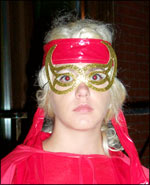As a college student in 1964, David J. Hufford met the dreaded Night Crusher. Exhausted from a bout of mononucleosis and studying for finals, Hufford retreated one December day to his rented, off-campus room and fell into a deep sleep. An hour later, he awoke with a start to the sound of the bedroom door creaking openâ€â€the same door he had locked and bolted before going to bed. Hufford then heard footsteps moving toward his bed and felt an evil presence. Terror gripped the young man, who couldn’t move a muscle, his eyes plastered open in fright.
Without warning, the malevolent entity, whatever it was, jumped onto Hufford’s chest. An oppressive weight compressed his rib cage. Breathing became difficult, and Hufford felt a pair of hands encircle his neck and start to squeeze. “I thought I was going to die,” he says.
At that point, the lock on Hufford’s muscles gave way. He bolted up and sprinted several blocks to take shelter in the student union. “It was very puzzling,” he recalls with a strained chuckle, “but I told nobody about what happened.”
Hufford’s perspective on his strange encounter was transformed in 1971. He was at that time a young anthropologist studying folklore in Newfoundland, and he heard from some of the region’s inhabitants about their eerily similar nighttime encounters. Locals called the threatening entity the “old hag.” Most cases unfold as follows: A person wakes up paralyzed and perceives an evil presence. A hag or witch then climbs on top of the petrified victim, creating a crushing sensation on his or her chest.
It took Hufford another year to establish that what he and these people of Newfoundland had experienced corresponds to the event, lasting seconds or minutes, that sleep researchers call sleep paralysis. …
Sleep paralysis differs from nocturnal panic, in which a person awakens in terror with no memory of a dream. Neither does sleep paralysis resemble a night terror, in which a person suddenly emerges from slumber in apparent fear, flailing and shouting, but then falls back asleep and doesn’t recall the incident in the morning.
Curiously, although the word nightmare originally described sleep paralysis, it now refers to a fearful or disturbing dream, says Hufford, now at the Penn State Medical Center in Hershey, Pa. Several hundred years ago, the English referred to nighttime sensations of chest pressure from witches or other supernatural beings as the “mare,” from the Anglo-Saxon merran, meaning to crush. The term eventually morphed into nightmareâ€â€the crusher who comes in the night. …
Many who experience sleep paralysis also report sensations of floating, flying, falling, or leaving one’s body. The condition’s primary emotion, terror, sometimes yields to feelings of excitement, exhilaration, rapture, or ecstasy. “A small number of people, while acknowledging fear during initial episodes of sleep paralysis, come to enjoy the experience,” Cheyne says. …
Two brain systems contribute to sleep paralysis, Cheyne proposes. The most prominent one consists of inner-brain structures that monitor one’s surroundings for threats and launches responses to perceived dangers. As Cheyne sees it, REM-based activation of this system, in the absence of any real threat, triggers a sense of an ominous entity lurking nearby. Other neural areas that contribute to REM-dream imagery could draw on personal and cultural knowledge to flesh out the evil presence.
A second brain system, which includes sensory and motor parts of the brain’s outer layer, distinguishes one’s own body and self from those of other creatures. When REM activity prods this system, a person experiences sensations of floating, flying, falling, leaving one’s body, and other types of movement, Cheyne says. …
There is a kinship between waking nightmares starring Night Crushers and reports of alien abductions, McNally and Clancy find. For more than a decade, they have been studying people who claim to have been abducted by aliens from outer space. McNally and Clancy are convinced that these claims derive from sleep-paralysis hallucinations.

 SHOCKED six-year-old Leah Lowland checked out a mystery bulge on her Incredible Hulk doll — and uncovered a giant green WILLY.
SHOCKED six-year-old Leah Lowland checked out a mystery bulge on her Incredible Hulk doll — and uncovered a giant green WILLY.
 For the past seven years Terrifica has been patrolling New York’s party and bar scene, looking out for women who have had a little too much to drink and are in danger of being taken advantage of by men. She says she has saved several women from both themselves and predators who would prey upon their weaknesses — both from alcohol and a misguided notion that they have to go out drinking to find a companion.
For the past seven years Terrifica has been patrolling New York’s party and bar scene, looking out for women who have had a little too much to drink and are in danger of being taken advantage of by men. She says she has saved several women from both themselves and predators who would prey upon their weaknesses — both from alcohol and a misguided notion that they have to go out drinking to find a companion.